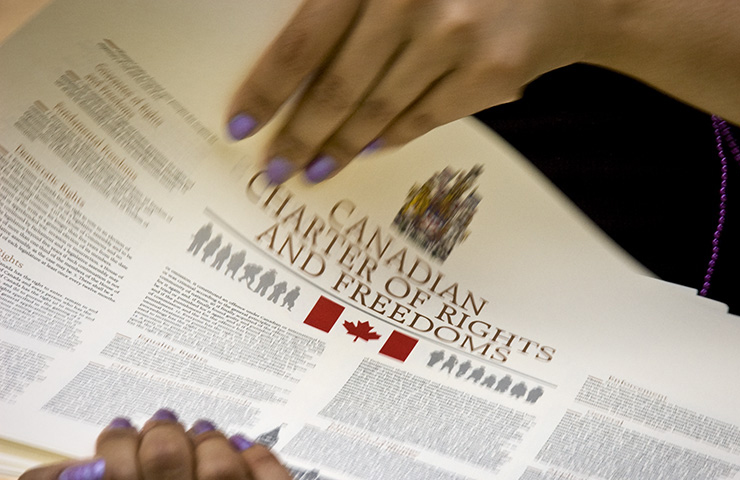Elementary Lessons
)
Title
Rights and Responsibilities in a Democracy
Guiding Question
What rights do I have as a Canadian? What responsibilities go along with my rights?
OVERVIEW
To be active and effective citizens, Canadians need to understand their rights and responsibilities.
In this unit, students explore the rights they have at school as an entry point to a discussion about rights and freedoms in a democracy. Students review the seven categories of the Canadian Charter of Rights and Freedoms. Through a scavenger hunt activity, students navigate the Charter itself and improve their understanding of its application. In the Consolidation activity, students reflect on the responsibilities that go along with their rights.
LEARNING GOALS
We are learning to:
- think critically about the rights and responsibilities we have at school (Concepts of Thinking – Significance);
- interpret the political and civil rights articulated in the Canadian Charter of Rights and Freedoms (Concepts of Thinking – Significance);
- understand the responsibilities that we have as Canadian citizens;
- recognize discrimination and promote the principles of equity, human rights and democratic participation.
SUCCESS CRITERIA
I CAN…
- describe the rights and responsibilities I have at school and why they are important;
- explain why the Canadian Charter of Rights and Freedoms has different meaning for different people and groups;
- describe how the Charter impacts my life;
- explain the responsibilities that go along with my rights and freedoms;
- analyze the importance of equality, human rights and democratic participation and the need for equity.
CURRICULUM LINKS
Social Studies Gr. 5 B3, B3.1
Writing 1, 1.6
Reading 1, 4, 1.4, 1.8, 4.1
MINDS ON
Rights vs Responsibilities
1. Discuss the idea of a ‘right’ and ask students to brainstorm a list of rights they have at school. A right is a freedom that is protected. Some examples include:
- The right to learn and receive an education
- The right to express yourself
- The right to a clean and safe space
- The right to be treated fairly and respectfully
- The right to make your own friends
2. Explain the concept that rights come with responsibilities. A responsibility is a duty, obligation or an expectation of how you should act.
Review your school’s code of conduct (this can often be found on your school or school board’s website, or within student agendas). Connect the specific student responsibilities back to the list of rights created by the class, making additions where necessary.
3. In small groups, ask students to brainstorm a list of expectations for both students and teachers that could be added to your school’s code of conduct.
4. Debrief through a whole class discussion. Guiding questions:
- Why is it important to know your rights?
- Why is it important to know your responsibilities?
- Why should you be a responsible student? How does it contribute to the school community?
- Do you think students are aware of their rights and responsibilities at school? How could this be improved?
ACTION
1. Distribute copies of the Anticipation Guide (Activity 3.1) to assess current knowledge about rights in Canada.
2. As a class, review the seven categories of the Canadian Charter of Rights and Freedoms. You can use either Handout 3.2 and/or the accompanying slide deck to support this review, or access the original version.
3. Ask students to complete a scavenger hunt using the summary of the Canadian Charter of Rights and Freedoms (Activity 3.3). The purpose is to help students interpret the Charter and understand what it means for different groups. Give students time to complete it independently and then share their responses in pairs or small groups.
Alternative Activity:
Individually, in pairs or groups, ask students to create a pamphlet or poster (their choice) aimed at informing new immigrants to Canada about their rights. Sample criteria:
- Choose three rights you think would be most important for newcomers to Canada to be aware of
- Create an eye-catching title that will attract the attention of your intended audience
- Use symbols that will help explain the rights for people who are English Language Learners
- Select headings that are meaningful and appropriate for the chosen rights
CONSOLIDATION
1. In pairs or small groups, ask students to consider the responsibilities that go along with each right using Activity 3.4. Afterwards, review as a class.
2. Have a closing discussion about rights and responsibilities, or ask students to write a reflection on one or more of the following questions:
- Which rights do you think are most important and why?
- Why are equality and diversity important? How are they reflected in the Charter?
- What is the difference between equity and equality? (Activity 3.5).
TIPS FOR TEACHERS
- Consider inviting your principal or vice-principal into your class to listen to suggestions for additional student expectations/responsibilities for your code of conduct or ways to improve awareness of student rights and responsibilities.
- Do your classroom rules need an update? Work with your class to re-write them in the “I have the right to… and I have the responsibility to….” format.
SUPPLEMENTARY TOOLSf
- Slide Deck: Rights and Responsibilities [PPT]
- Activity 3.1: Anticipation Guide [PDF] [Word]
- Handout 3.2: Highlights from the Canadian Charter of Rights and Freedoms [PDF]
- Activity 3.3: Charter Scavenger Hunt [PDF] [Word]
- Activity 3.4: Our Rights and Responsibilities [PDF] [Word]
- Activity 3.5: Equality and Equity [PDF] [Word]